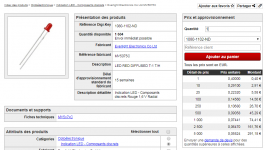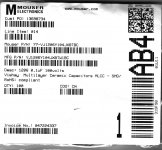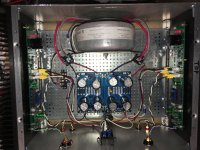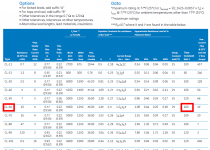"Do not substitute" is an unambiguous phrase; it has one meaning only.
I can think of two possible options. {a} buy from a seller outside France; {b} buy from a seller inside France, whose name is not Mouser.
For further information refer to the M2x thread, post #461 -- 04 August 2018. Also, look at the attachment below.
_
I can think of two possible options. {a} buy from a seller outside France; {b} buy from a seller inside France, whose name is not Mouser.
For further information refer to the M2x thread, post #461 -- 04 August 2018. Also, look at the attachment below.
_
Attachments
Frenchy,
Within Europe you could try Conrad.
Apparently, they don't have this item in stock, but the waiting time is not too long, and they are a reliable source.
Everlight Opto MV5075C LED wired Red Circular 3 mm 1.5 mcd 90 deg 35 mA 1.6 V from Conrad.com
Within Europe you could try Conrad.
Apparently, they don't have this item in stock, but the waiting time is not too long, and they are a reliable source.
Everlight Opto MV5075C LED wired Red Circular 3 mm 1.5 mcd 90 deg 35 mA 1.6 V from Conrad.com
Last edited:
hello
I'm moving on with my M2X project, the maps from diyaudiostore have arrived. They are beautiful.
Concerning the MV5075C LED not found at Mouser for France, I mixed my order with Digikey (because it is available at home) to benefit from the free shipping costs. Thank you for your help.
And as I move forward in my list of components, questions, perhaps, stupid questions come up and others find their answers.
Here are two of them:
should the mosfet IRFP240 and IRFP9240 be paired with each other?
and if so, how?
thank you in advance.
I'm moving on with my M2X project, the maps from diyaudiostore have arrived. They are beautiful.
Concerning the MV5075C LED not found at Mouser for France, I mixed my order with Digikey (because it is available at home) to benefit from the free shipping costs. Thank you for your help.
And as I move forward in my list of components, questions, perhaps, stupid questions come up and others find their answers.
Here are two of them:
should the mosfet IRFP240 and IRFP9240 be paired with each other?
and if so, how?
thank you in advance.
I've been flip flopping between the M2 and the AJ just so I can get a good mental foundation on H2 vs H3 roughly speaking. Which daughter card should I look into that's on the dryer side? Just want to see where my personal preferences will lie regarding PP topology. I'm currently using the Ishikawacard with authentic shibas
Frenchy - No matching necessary.
Blk Dynamite - No idea. Maybe put the daughter card in dessicant before use, or drink brut Champaign while listening...?
I may try some Gin as i'm not a champagne fan.....unless you make a Black Velvet (champagne and Guinness) which is quite tasty.
If the gin or Guinness doesn't work, suggest trying the Tucson or Austin. Both are less flavored than either the Ishikawa or the Mountain View. Not sure I would call them "dry". I'm listening to the Austin right now and I like it a lot. Actually, all of the cards sound quite good and none of them significantly skew the overall warm, romantic nature of the M2x.
If the gin or Guinness doesn't work, suggest trying the Tucson or Austin. Both are less flavored than either the Ishikawa or the Mountain View. Not sure I would call them "dry". I'm listening to the Austin right now and I like it a lot. Actually, all of the cards sound quite good and none of them significantly skew the overall warm, romantic nature of the M2x.
Cool, ill look into those two and make a purchase. Gives me something to do during the upcoming holiday break. Thanks
The Review Committee and I are working on some additional IPS daughterboards, see post #746. Good news: some are extremely pleasant. Better news: there's no hurry, there's no deadline, there's no timetable. New daughterboard candidates keep appearing and we evaluate them, on a comfortable schedule, without time pressure. The absence of a Profit Motive is palpable.
Just ordered my PCBs, is ot OK to use the WHAMMY as a pre amp for this build?
Yes, you can use the WHAMMY or most any other HA as a preamp.
Just as a precaution...I would measure the WHAMMY's or any other HA's offset before connecting it to the M2.
Norwood parts question
BOM for Norwood lists:
Part ID: C1, C2, C3, C5
Value = .1uF 50V MLCC 1206 SMD. with the mouser part# 77-VJ1206Y104JXBTBC.
When I pull up this part it is listed as a Multilayer Ceramic Capacitors MLCC - SMD/SMT 1206 0.1uF 100volts X7R 5%
So, is the part number correct and the BOM should list it as 100volts. Or is the part number wrong and I should look for a .1uF 50V MLCC 1206 SMD such as a mouser part# 810-CGJ5L2C0G1H104J (TDK MLCC - SMD/SMT CGJ 1206 50V 0.1uF 5% T:1.6mm AEC-Q200)?
CGJ5L2C0G1H104J160AA TDK | Mouser
Or is it that the volts is not important?
Thanks
Ses
BOM for Norwood lists:
Part ID: C1, C2, C3, C5
Value = .1uF 50V MLCC 1206 SMD. with the mouser part# 77-VJ1206Y104JXBTBC.
When I pull up this part it is listed as a Multilayer Ceramic Capacitors MLCC - SMD/SMT 1206 0.1uF 100volts X7R 5%
So, is the part number correct and the BOM should list it as 100volts. Or is the part number wrong and I should look for a .1uF 50V MLCC 1206 SMD such as a mouser part# 810-CGJ5L2C0G1H104J (TDK MLCC - SMD/SMT CGJ 1206 50V 0.1uF 5% T:1.6mm AEC-Q200)?
CGJ5L2C0G1H104J160AA TDK | Mouser
Or is it that the volts is not important?
Thanks
Ses
Oops, that's an error in the BOM. I bought 100 volt capacitors myself (see image below), I wanted other people to buy 100 volt capacitors, and I put the correct part number for 100 volt capacitors in the BOM. But in the description field I erroneously typed 50 volts. I meant 100 volts. Thanks for the great catch!
Of course it doesn't matter too much in an actual Norwood board. Those are power supply bypass capacitors and they run at about 30 volts in normal operation. Using 100 volt caps gives extra safety margin, and the higher voltage dielectric has slightly less C-versus-V droop too. 50V ceramic caps would work okay in the board, but if you haven't ordered parts yet, I recommend ordering 100V caps instead. They're very inexpensive.
_
Of course it doesn't matter too much in an actual Norwood board. Those are power supply bypass capacitors and they run at about 30 volts in normal operation. Using 100 volt caps gives extra safety margin, and the higher voltage dielectric has slightly less C-versus-V droop too. 50V ceramic caps would work okay in the board, but if you haven't ordered parts yet, I recommend ordering 100V caps instead. They're very inexpensive.
_
Attachments
Last edited:
M2-x blowing fuses 
View attachment 714803 Hello All,
I finally had some time to complete my M2-x build, minus the final front panel that I'm still undecided on. I'm also using a temporary 400VA toroid until I purchase my new one. I systematically tested the power supply, then each board individually using my bulb tester and all went well. To set the offset I even purchased a pair of 50watt, 8 ohm, 1% resistors and again all went well, let the amp run for a while and observed as the heat sinks came up to a final temperature of 51 degrees Celsius. I turned the amp off to hook up a pair of test speakers and a cable to my iPhone for the input to see if it would play music. When I tuned the amp back on I blew the 2.5 amp slow blow fuse as is used in the original M2. Replaced that and the amp turned on and played music from both channels without issue for about an hour. However, when I turned the amp off and back on to check if the offset had drifted it again blew the fuse. Once again changing the fuse allowed the amp to turn on, but continues to blow the fuse after any power cycle. I'm Not sure what to check and would like some guidance. Unfortunately the server will currently only let me upload one pic at a time, I will send a few more asap.
View attachment 714803 Hello All,
I finally had some time to complete my M2-x build, minus the final front panel that I'm still undecided on. I'm also using a temporary 400VA toroid until I purchase my new one. I systematically tested the power supply, then each board individually using my bulb tester and all went well. To set the offset I even purchased a pair of 50watt, 8 ohm, 1% resistors and again all went well, let the amp run for a while and observed as the heat sinks came up to a final temperature of 51 degrees Celsius. I turned the amp off to hook up a pair of test speakers and a cable to my iPhone for the input to see if it would play music. When I tuned the amp back on I blew the 2.5 amp slow blow fuse as is used in the original M2. Replaced that and the amp turned on and played music from both channels without issue for about an hour. However, when I turned the amp off and back on to check if the offset had drifted it again blew the fuse. Once again changing the fuse allowed the amp to turn on, but continues to blow the fuse after any power cycle. I'm Not sure what to check and would like some guidance. Unfortunately the server will currently only let me upload one pic at a time, I will send a few more asap.
Attachments
JSA, congratulations on a tidy build! Your photo looks nice.
You may not have looked up the datasheet for the Inrush Current Limiter device which Nelson Pass included in the official M2 schematic: the venerable CL-60. Snippet attached below. The CL-60 works by having a high resistance when cold and a low resistance when hot.
The idea is, when the amp has been sitting for a good long while with the power off, all components inside are at room temperature, including the CL-60. We'll call that "cold". Then when you turn the power on, the mains is applied to the transformer primary through a pair of CL-60s which are cold. Therefore they are high resistance. Therefore the mains voltage is applied to a primary circuit that includes high resistance. Therefore the mains current is low. Eureka, Inrush Current Limiting. Aaah. As current continues to flow thru the CL-60s, they get warmer and warmer, and their resistance falls. Eventually they reach equilibrium and their resistance is very small, so they do not "get in the way" of applying AC mains to the transformer primary.
What happens when you turn the power OFF? The CL-60s begin to gradually cool. How gradually? See the datasheet. It might be a very wise plan to avoid turning the power switch back ON, for at least 100 seconds. If you're tempted to do that: don't do that. It might also be a very wise plan to re-route the wires and cables inside your chassis, so they are nowhere near the possibly-hot CL60s.
diyAudio moderator and all around good guy 6L6 uses a "Kill A Watt" device to monitor the AC current flowing from the mains into the M2x amplifier. If it's more than 1.4 amperes or so, that's an indication of a fault. First Watt's owners manual for the M2 says the amp consumes 160 watts from a 115 volt AC mains supply. Dividing these two numbers gives 1.4 amps. By the way, that's why Nelson Pass recommends a 2.5 Amp slow-blow fuse for 115V builds: 2.5A is comfortably greater than 1.4A. If the M2 pulls 2.5A or more then something is certainly wrong.
https://www.homedepot.com/p/Kill-A-Watt-Electricity-Monitor-P4400/202196386
Unfortunately, an Inrush Current event happens far too quickly to register on the cheap little Kill A Watt. It can only tell you whether the average current (over, let's say, a 5 second interval) is above or below 1.4 amps.
You might hunt around the Pass Labs forums for threads with activity in the last ten days or so, which include the words Inrush Current in their title. Might be some food for thought.
You may not have looked up the datasheet for the Inrush Current Limiter device which Nelson Pass included in the official M2 schematic: the venerable CL-60. Snippet attached below. The CL-60 works by having a high resistance when cold and a low resistance when hot.
The idea is, when the amp has been sitting for a good long while with the power off, all components inside are at room temperature, including the CL-60. We'll call that "cold". Then when you turn the power on, the mains is applied to the transformer primary through a pair of CL-60s which are cold. Therefore they are high resistance. Therefore the mains voltage is applied to a primary circuit that includes high resistance. Therefore the mains current is low. Eureka, Inrush Current Limiting. Aaah. As current continues to flow thru the CL-60s, they get warmer and warmer, and their resistance falls. Eventually they reach equilibrium and their resistance is very small, so they do not "get in the way" of applying AC mains to the transformer primary.
What happens when you turn the power OFF? The CL-60s begin to gradually cool. How gradually? See the datasheet. It might be a very wise plan to avoid turning the power switch back ON, for at least 100 seconds. If you're tempted to do that: don't do that. It might also be a very wise plan to re-route the wires and cables inside your chassis, so they are nowhere near the possibly-hot CL60s.
diyAudio moderator and all around good guy 6L6 uses a "Kill A Watt" device to monitor the AC current flowing from the mains into the M2x amplifier. If it's more than 1.4 amperes or so, that's an indication of a fault. First Watt's owners manual for the M2 says the amp consumes 160 watts from a 115 volt AC mains supply. Dividing these two numbers gives 1.4 amps. By the way, that's why Nelson Pass recommends a 2.5 Amp slow-blow fuse for 115V builds: 2.5A is comfortably greater than 1.4A. If the M2 pulls 2.5A or more then something is certainly wrong.
https://www.homedepot.com/p/Kill-A-Watt-Electricity-Monitor-P4400/202196386
Unfortunately, an Inrush Current event happens far too quickly to register on the cheap little Kill A Watt. It can only tell you whether the average current (over, let's say, a 5 second interval) is above or below 1.4 amps.
You might hunt around the Pass Labs forums for threads with activity in the last ten days or so, which include the words Inrush Current in their title. Might be some food for thought.
Attachments
- Home
- Amplifiers
- Pass Labs
- The diyAudio First Watt M2x




